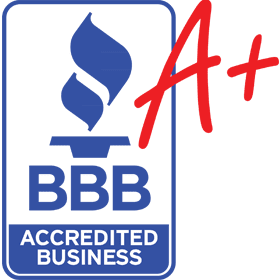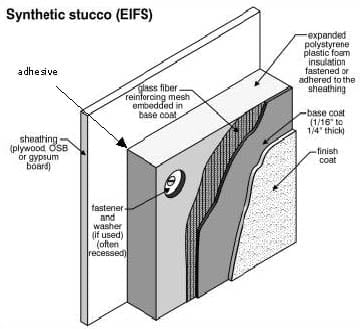



What is Exterior Insulation and Finish Systems (E.I.F.S.)?
EIFS (Exterior Insulation and Finish Systems) is a non-bearing wall system. Originally, its purpose was to resurface masonry buildings that had been devastated by the war. In 1969, EIFS was first used in the United States. Ever since, it has been a popular choice for many builders and architects, mainly in the construction of commercial buildings. However, EIFS is also popular in home construction. Also known as “synthetic stucco,” EIFS consists of a multi-layer exterior barrier-type system designed to prevent water intrusion in exterior walls.
The system has four main components:

- Panels of expanded polystyrene foam insulation board (similar to foam coffee cups). These are installed with adhesive or mechanically fastened to the substrate, which is usually plywood, oriented strandboard or exterior-type gypsum board.
- A polymer-cement base coat. This is troweled over the foam insulation panels.
- A glass fiber reinforcing mesh. This is laid over the polystyrene insulation panels and embedded in the base coat.
- A 100% acrylic color-integral finish coat. This is then troweled over the base coat and reinforcing mesh.
EIFS systems are usually about 1/8″ to 1/4″ thick.
What are the advantages of EIFS?
One of the main advantages of EIFS is that it acts as a great insulator. Indeed, it literally wraps the exterior in an energy-efficient thermal envelope. It also decreases air infiltration, stabilizes the interior, and reduces energy consumption.
EIFS also provides a rich, more uniform appearance than regular color stucco. At the same time, it is a more flexible material. This makes it less prone to cracking than traditional stucco. EIFS are also among the most water-resistant exterior surfaces you can put on a house.
As with all wall systems, however, EIFS must be correctly installed by an EIFS certified professional. It’s also important to follow the manufacturer’s recommendations. Moisture can easily damage an improperly installed synthetic stucco system. This is important since EIFS is not a breathable material. Thus, you need to seal all flashings around windows and doors to prevent water intrusion. It’s also important to address cracks in the EIFS system to prevent water damage.
Furthermore, EIFS manufacturers have now come up with new drainable EIFS systems that will prevent water from getting behind the stucco.
Here at Old Pueblo Stucco LLC, we are EIFS Certified applicators. Our team has more than 20 years of experience working with EIFS systems. We adhere to the highest standards of workmanship, so that we can deliver the best possible products to our clients. Please call us at 520-304-7037 to get a free estimate.
Traditional Stucco
Portland cement plaster ( “stucco” ) is a hard, durable, time-tested exterior finish. It consists of Portland cement-based materials and sand mixed with water to form a workable plaster.
Just like Portland cement strengthens structures such as highways, bridges and skyscrapers, it also provides strength, high-impact resistance and durability to stucco. Portland cement plaster has been used over frame construction in the U.S. for more than a century.
You can apply stucco over wood frame construction in one of two ways:
One Coat Stucco. In this method, you’ll attach wire fabric lath (“stucco netting”) to a layer of expanded polystyrene foam board insulation. Two layers of grade “D” building paper are attached to the wood sheathing. Then, apply stucco in a two coat system: one fiber-reinforced base coat and one texture finish coat.
Traditional Three-Coat Stucco. In this method, you’ll attach paper-backed metal lath directly to the wood sheathing, without the foam board insulation. Then, apply stucco in three layers: a scratch coat, a brown coat, and a texture finish coat. In both systems, a 100% acrylic color finish coat or “synthetic finish” can be used as the final coat instead of the regular cement finish coat.
At Old Pueblo Stucco LLC, our team has the knowledge and experience necessary to install stucco using any method. We can install stucco over block, concrete, wood or metal framing, Insulated Concrete Forms (ICF) or Aerated Autoclaved Concrete blocks (AAC). No matter what you need, we’ll do the job right the first time!


